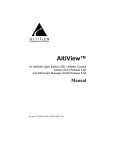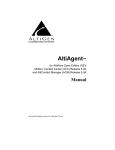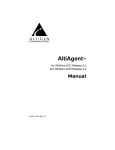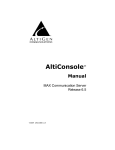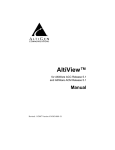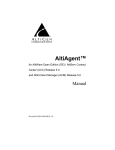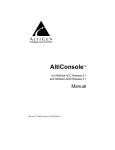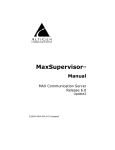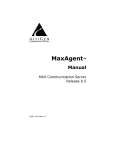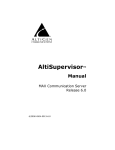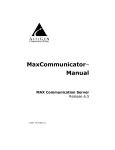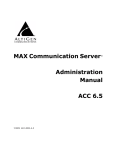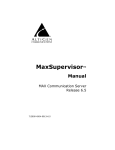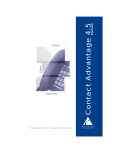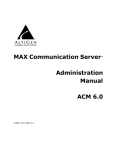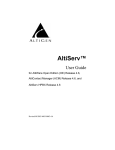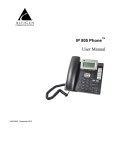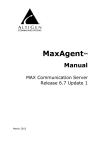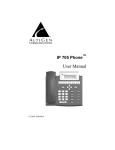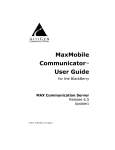Download Altigen MAXCS ACC 6.5 Specifications
Transcript
AltiAgent™ Manual MAX Communication Server Release 6.0 6/2008 4503-0001-6.0 WARNING! Toll fraud is committed when individuals unlawfully gain access to customer telecommunication systems. This is a criminal offense. Currently, we do not know of any telecommunications system that is immune to this type of criminal activity. AltiGen Communications, Inc. will not accept liability for any damages, including long distance charges, which result from unauthorized and/or unlawful use. Although AltiGen Communications, Inc. has designed security features into its products, it is your sole responsibility to use the security features and to establish security practices within your company, including training, security awareness, and call auditing. NOTICE While every effort has been made to ensure accuracy, AltiGen Communications, Inc., will not be liable for technical or editorial errors or omissions contained within the documentation. The information contained in this documentation is subject to change without notice. This documentation may be used only in accordance with the terms of the AltiGen Communications, Inc., License Agreement. AltiGen Communications, Inc. 4555 Cushing Pkwy. Fremont, CA 94538 Telephone: 510-252-9712 Fax: 510-252-9738 E-mail: [email protected] Web site: www.altigen.com TRADEMARKS MAX Communication Server, MaxAdministrator, MaxCommunicator, Enterprise Manager, AltiServ, AltiLink, AltiConsole, VRPlayer, Zoomerang, IPTalk, Alti-Mobile Extension, AltiReport, and SuperQ are trademarks or registered trademarks of AltiGen Communications, Inc. All other brand names mentioned are trademarks or registered trademarks of their respective manufacturers. Copyright © AltiGen Communications, Inc. 2008. All rights reserved. Part Number 4503-0001-6.0 Contents Contents . . . . . . . . . . . . . . . . . . . . . . . . . . . . . . . . . . . . . . . . . . . . . i Warranty . . . . . . . . . . . . . . . . . . . . . . . . . . . . . . . . . . . . . . . . . . . . v CHAPTER 1 About AltiAgent . . . . . . . . . . . . . . . . . . . . . . . . . . . . . . . . . . . . 1 New in Release 6.0 . . . . . . . . . . . . . . . . . . . . . . . . . . . . . . . . . . . . . . 1 Microsoft Outlook and Outlook Express Support . . . . . . . . . . . . . . 1 ACT!/GoldMine® Support . . . . . . . . . . . . . . . . . . . . . . . . . . . . . . . 2 Licensing . . . . . . . . . . . . . . . . . . . . . . . . . . . . . . . . . . . . . . . . . . . . . 2 CHAPTER 2 Installation . . . . . . . . . . . . . . . . . . . . . . . . . . . . . . . . . . . . . . . . . 3 Pre-Installation Checklist . . . . . . . . . . . . . . . . . . . . . . . . . . . . . . . . . 3 Installing AltiAgent on a Client System . . . . . . . . . . . . . . . . . . . . . 3 Uninstalling AltiAgent . . . . . . . . . . . . . . . . . . . . . . . . . . . . . . . . . . . 4 Automatic Upgrade . . . . . . . . . . . . . . . . . . . . . . . . . . . . . . . . . . . . . 4 Downgrade Procedure . . . . . . . . . . . . . . . . . . . . . . . . . . . . . . . . . . . 4 CHAPTER 3 Getting Started . . . . . . . . . . . . . . . . . . . . . . . . . . . . . . . . . . . . . 7 Logging In . . . . . . . . . . . . . . . . . . . . . . . . . . . . . . . . . . . . . . . . . . . . 7 Workgroup Login . . . . . . . . . . . . . . . . . . . . . . . . . . . . . . . . . . . . . 8 Logging Out or Changing Workgroups . . . . . . . . . . . . . . . . . . . . . . 9 Version Mismatch Dialog Box . . . . . . . . . . . . . . . . . . . . . . . . . . . . 9 Reconnecting to AltiAgent . . . . . . . . . . . . . . . . . . . . . . . . . . . . . . . . 9 Logging In Remotely . . . . . . . . . . . . . . . . . . . . . . . . . . . . . . . . . . . 10 IP Extensions Using IP Talk. . . . . . . . . . . . . . . . . . . . . . . . . . . . 10 Troubleshooting IP Connectivity . . . . . . . . . . . . . . . . . . . . . . . . 11 Exiting and Minimizing AltiAgent . . . . . . . . . . . . . . . . . . . . . . . . 11 Using the Windows Tray Phone Icon. . . . . . . . . . . . . . . . . . . . . 11 AltiAgent Manual i Resizing the Display. . . . . . . . . . . . . . . . . . . . . . . . . . . . . . . . . . 12 CHAPTER 4 Using AltiAgent as a Workgroup Agent . . . . . . . . . . . . . . . .15 Dialing . . . . . . . . . . . . . . . . . . . . . . . . . . . . . . . . . . . . . . . . . . . . Placing Calls on Hold. . . . . . . . . . . . . . . . . . . . . . . . . . . . . . . . . Using Call Waiting. . . . . . . . . . . . . . . . . . . . . . . . . . . . . . . . . . . Transferring Calls. . . . . . . . . . . . . . . . . . . . . . . . . . . . . . . . . . . . Conference Calls . . . . . . . . . . . . . . . . . . . . . . . . . . . . . . . . . . . . . . Station Conferencing . . . . . . . . . . . . . . . . . . . . . . . . . . . . . . . . . MeetMe Conference . . . . . . . . . . . . . . . . . . . . . . . . . . . . . . . . . . . Working in the MeetMe Conference Window . . . . . . . . . . . . . . Creating a Meeting . . . . . . . . . . . . . . . . . . . . . . . . . . . . . . . . . . . E-mailing a Meeting Invitation . . . . . . . . . . . . . . . . . . . . . . . . . Starting and Stopping a Meeting . . . . . . . . . . . . . . . . . . . . . . . . What the MeetMe Conference Host Can Do . . . . . . . . . . . . . . . Continuing a Meeting Beyond Its Duration Time . . . . . . . . . . . Joining a MeetMe Conference . . . . . . . . . . . . . . . . . . . . . . . . . . Recording Calls . . . . . . . . . . . . . . . . . . . . . . . . . . . . . . . . . . . . . . . Recording on Demand . . . . . . . . . . . . . . . . . . . . . . . . . . . . . . . . Using Account Codes . . . . . . . . . . . . . . . . . . . . . . . . . . . . . . . . . . Listening to Your Voice Mail . . . . . . . . . . . . . . . . . . . . . . . . . . Saving Remotely or Locally. . . . . . . . . . . . . . . . . . . . . . . . . . . . Deleting a Message . . . . . . . . . . . . . . . . . . . . . . . . . . . . . . . . . . Returning the Call . . . . . . . . . . . . . . . . . . . . . . . . . . . . . . . . . . . Attaching a Note. . . . . . . . . . . . . . . . . . . . . . . . . . . . . . . . . . . . . Forwarding Voice Mail . . . . . . . . . . . . . . . . . . . . . . . . . . . . . . . Working with Voice Mail Groups (Distribution Lists) . . . . . . . Setting Status to Ready or Not Ready . . . . . . . . . . . . . . . . . . . . . . Viewing, Sharing, or Pushing Data . . . . . . . . . . . . . . . . . . . . . . . . Viewing Caller Data. . . . . . . . . . . . . . . . . . . . . . . . . . . . . . . . . . Sharing or Sending a URL or Page . . . . . . . . . . . . . . . . . . . . . . Monitoring . . . . . . . . . . . . . . . . . . . . . . . . . . . . . . . . . . . . . . . . . . . Choosing Workgroups to Monitor . . . . . . . . . . . . . . . . . . . . . . . Reading the Monitor List . . . . . . . . . . . . . . . . . . . . . . . . . . . . . . Calling or Picking Up Calls . . . . . . . . . . . . . . . . . . . . . . . . . . . . ii AltiAgent Manual 20 23 23 23 26 27 29 30 31 35 36 36 36 37 37 37 39 41 42 42 42 42 43 44 45 45 45 46 47 47 48 49 Viewing the Call History . . . . . . . . . . . . . . . . . . . . . . . . . . . . . . . . 49 Viewing Workgroup Statistics . . . . . . . . . . . . . . . . . . . . . . . . . . 50 Viewing Queues . . . . . . . . . . . . . . . . . . . . . . . . . . . . . . . . . . . . . 52 Pick Up Calls from Queue . . . . . . . . . . . . . . . . . . . . . . . . . . . . . 52 Using ActiveX Control with Third Party Applications . . . . . . . . . 53 CHAPTER 5 Configuring Your Station Settings . . . . . . . . . . . . . . . . . . . . 55 Default Trunk Access . . . . . . . . . . . . . . . . . . . . . . . . . . . . . . . . . 56 Voice Mail Play Options . . . . . . . . . . . . . . . . . . . . . . . . . . . . . . 57 IPTalk . . . . . . . . . . . . . . . . . . . . . . . . . . . . . . . . . . . . . . . . . . . . . 57 Screen Pop, Audio Beep, and Auto Close . . . . . . . . . . . . . . . . . 57 Accessing Databases. . . . . . . . . . . . . . . . . . . . . . . . . . . . . . . . . . 58 Color Selection . . . . . . . . . . . . . . . . . . . . . . . . . . . . . . . . . . . . . . 59 Miscellaneous . . . . . . . . . . . . . . . . . . . . . . . . . . . . . . . . . . . . . . . 59 Advanced Options for Web-based and Workgroup Calls . . . . . 59 One Number Access (ONA) . . . . . . . . . . . . . . . . . . . . . . . . . . . . . 60 Before You Set Up ONA . . . . . . . . . . . . . . . . . . . . . . . . . . . . . . 60 Setting Up One Number Access . . . . . . . . . . . . . . . . . . . . . . . . . 61 Call Handling . . . . . . . . . . . . . . . . . . . . . . . . . . . . . . . . . . . . . . . . . 63 Message Notification . . . . . . . . . . . . . . . . . . . . . . . . . . . . . . . . . . . 66 Voice Mail Groups (Distribution Lists) . . . . . . . . . . . . . . . . . . . 67 Working on Voice Mail Group Lists . . . . . . . . . . . . . . . . . . . . . 68 Station Speed Dialing Setup . . . . . . . . . . . . . . . . . . . . . . . . . . . . . 69 System Speed Dial Numbers . . . . . . . . . . . . . . . . . . . . . . . . . . . . . 71 Index . . . . . . . . . . . . . . . . . . . . . . . . . . . . . . . . . . . . . . . . . . . . . . . 73 AltiAgent Manual iii iv AltiAgent Manual Warranty What The Warranty Covers AltiGen Communications warrants its hardware products to be free from defects in material and workmanship during the warranty period. If a product proves to be defective in material or workmanship during the warranty period, AltiGen Communications will, at its sole option, repair, refund or replace the product with a like product. How Long the Warranty Is Effective All AltiGen Communications products are warranted for one year for all parts from the date of the first end user purchase. Whom the Warranty Protects This warranty is valid only for the first end user purchaser. What the Warranty Does Not Cover 1. Any product on which the serial number has been defaced, modified or removed. 2. Damage, deterioration or malfunction resulting from: a) Accident, misuse, neglect, fire, water, lightning, or other acts of nature, unauthorized product modification, or failure to follow instructions supplied with the product. b) Repair or attempted repair by anyone not authorized by AltiGen Communications. c) Any damage of the product due to shipment. d) Removal or installation of the product. e) Causes external to the product, such as electric power fluctuations or failure. f) Use of supplies or parts not meeting AltiGen Communications’ specifications. g) Normal wear and tear. h) Any other cause which does not relate to a product defect. 3. Shipping, installation, set-up and removal service charges. How to Obtain Service End user customers should contact your Authorized AltiGen Dealer for service. Authorized AltiGen Dealers must follow the steps below for service: AltiAgent Manual v 1. Take or ship the product (shipment prepaid) to your AltiGen distributor or to AltiGen Communications, Inc. All materials being returned to AltiGen must have an associated RMA number. RMA numbers are issued by AltiGen Customer Service and can be obtained by calling 1-888ALTIGEN (258-4436) or faxing an RMA form to 510-252-9738, attention to Customer Service. AltiGen reserves the right to refuse return of any material that does not have an RMA number. The RMA number should be clearly marked on the outside of the box in which the material is being returned. For example: Attn.: RMA # 123 AltiGen Communications, Inc. 4555 Cushing Pkwy. Fremont, CA 94538 Upon authorization of return, AltiGen will decide whether the malfunctioning product will be repaired or replaced. 2. To obtain warranty service, you will be required to provide: a) the date and proof of purchase b) serial number of the product c) your name and company name d) your shipping address e) a description of the problem. 3. For additional information contact your AltiGen Dealer or AltiGen Communications, Inc. Effect of State Law This warranty gives you specific legal rights, and you may also have other rights which vary from state to state. Some states do not allow limitations on implied warranties and/or do not allow the exclusion of incidental or consequential damages, so the above limitations and exclusions may not apply to you. Sales Outside the U.S.A. For AltiGen Communications products sold outside of the U.S.A., contact your AltiGen Communications dealer for warranty information and services. vi AltiAgent Manual CHAPTER 1 Installation About AltiAgent AltiAgent is a Windows desktop application designed to improve the performance of workgroup and call center agents in a MAX Communication Server ACC/ACM (MAXCS) environment. AltiAgent allows workgroup agents to manage workgroup calls from their computers. It allows direct access to call handling and other functions, including the following: • Viewing caller data (for example, IP address, account number, credit card number, name, and so on) sent with an incoming call. • Pushing or sending a URL or web page to a web-based call. • Viewing and printing workgroup call data. With AltiAgent, you can monitor workgroup-related statistics, workgroup call pickup, and member login/logout. In addition, AltiAgent integrates with Microsoft Outlook and Outlook Express, ACT!, and GoldMine® for caller screen pops and dialing out from these applications. Call information can be stored to an internal or external CDR database for future review and analysis. New in Release 6.0 • E.164 support for call history and return calls • E.164 number support when dialing from Outlook Microsoft Outlook and Outlook Express Support AltiAgent 6.0 supports Microsoft Outlook 2003 and 2007, and Outlook Express 5.0, allowing you to obtain phone numbers to dial from a Microsoft Outlook Contact list. AltiAgent also lets you see the incoming calls that have a matching record in the Contact list. You must set up the Outlook Contacts list prior to using this feature. A Country Code field can be configured (in the Configuration window, General Info tab) by the local user to help convert standard international phone numbers in Outlook to correct digit strings for MAXCS. AltiAgent Manual 1 ACT!/GoldMine® Support AltiAgent 6.0 supports ACT! 2005, 2006, and 2007 and GoldMine® 6.0, 6.5, and 6.7 contact management software, allowing you to obtain phone numbers to dial from the ACT! or GoldMine® contact database list. AltiAgent also lets you see the matching record from the contact database list of the incoming calls. Licensing The following AltiGen licenses are required: • AltiAgent requires an AltiAgent seat license for each user. • The IPTalk feature requires an IPTalk license for each user. • ACT! and GoldMine integration require an Integration Connector license for each user. A system administrator can verify the licenses in MaxAdministrator by selecting License > Client License Management from the main menu. 2 AltiAgent Manual CHAPTER 2 Installation Installation The client system must meet the following minimum requirements. • IBM/PC AT compatible system • 1GHz CPU or above • Windows XP Professional or Windows Vista Business Edition • 250 MB available hard drive disk space • 256 MB RAM • SVGA monitor (800 x 600) with 256 color display, or better • Keyboard and mouse • MAXCS ACC/ACM 6.0 running on a server accessible to this client. Pre-Installation Checklist Before installing AltiAgent, make sure the following is done: • MAXCS ACC/ ACM 6.0 has been installed on the system server. • TCP/IP is enabled on both machines. • The client is able to connect to the server on the network. • The person installing AltiAgent has local administrator rights on the client PC. • The AltiAgent License Key has been installed and activated on the system server. Installing AltiAgent on a Client System When the above items are done, follow these steps on the client machine: 1. Exit all Windows applications. 2. Insert the MAXCS 6.0 Clients CD into the CD ROM drive.. AltiAgent Manual 3 3. Open the AltiAgent folder, and run the Setup program in that folder, following the step-by-step installation instructions as they appear on the screen. Alternatively, if your system administrator has loaded AltiAgent on a shared network server, you can copy the files in the AltiAgent folder to your desktop PC, and run the AltiAgent Setup program. Uninstalling AltiAgent 1. From the Windows Start menu, select Control Panel > Add/Remove Programs > AltiAgent 6.0 to uninstall AltiAgent. 2. Click Remove, and respond to any additional prompts. Automatic Upgrade Each time you start up AltiAgent, a comparison is made with the version of MAXCS ACC/ACM that is running on the server. If updates were made on the server, and your version of AltiAgent is out-of-date, you are prompted for upgrade permission. If you automatically upgrade, the AltiAgent startup is terminated and a software upgrade session is started. Restart AltiAgent to run the newer version. Note: For remote AltiAgent users outside the firewall, TCP port 10050 is required to be open to allow automatic upgrade. Also, automatic upgrade over the Internet requires the sending of 15 MB files over the WAN, so it may take some time to perform the automatic update. Downgrade Procedure 1. Go to Control Panel > Add/Remove Programs and remove the AltiAgent 6.0 program and ALL OTHER 6.0 client applications (including MaxCommunicator, AltiSupervisor, AltiConsole and CDR Search 6.0). 2. Reboot your system. 3. Go to <local drive>:Program Files\AltiGen\Shared Files and remove AlpInterface.dll. 4 AltiAgent Manual 4. Install the earlier AltiAgent software, as appropriate. AltiAgent Manual 5 Installation Note: The AlpInterface might be located under \WinNT\System32\, \Windows\System32\ or some other location. Use the Search for Files and Folders feature to locate and remove all AlpInterface.dll files from the system. 6 AltiAgent Manual CHAPTER 3 Getting Started Start AltiAgent from the Microsoft Windows Start menu, by choosing Start > All Programs > AltiClient > AltiAgent If you are connecting to the Internet through a modem connection, before you log in, establish a session connection from your PC to your local Internet service provider. If you’re using a low-speed connection, the login may take some time, since a large amount of data is transferred to your desktop. Logging In 1. If this is your first login to this MAXCS ACC/ACM system, enter the system server’s IP address or the name of the system server you will be using. To obtain the server name or IP address, ask your IT administrator. (Subsequently, when you log in, you’ll see the IP address in the Server Name field.) 2. Enter your Extension number and Password assigned to your phone. AltiAgent Manual 7 Getting Started Note: For users running Windows XP SP2, a firewall protection Security Alert may pop up when opening the login window. If this happens, click Yes to allow AltiAgent to run. If you want to store your login password and have it entered automatically the next time you log in to AltiAgent, check the Always save password check box. Note: Up to eight unsuccessful login attempts are allowed, after which login will be disabled for from 1 to 24 hours (depending on the duration set by your system administrator). 3. If your extension is an IP extension and you will be using a headset, check the IP Extension Integrated with IPTalk option. (Even if you do not have an IP phone, as long as your extension is set up as an IP extension by your system administrator, you can select the IP Extension Integrated with IPTalk check box.) See “Logging In Remotely” on page 10 for more information on using IP extensions remotely. 4. Click OK. Workgroup Login After you complete your initial login, a Group Login dialog box appears. Select the workgroup or workgroups you want to log in to, then click OK. You can log in to eight workgroups simultaneously. Note: If you are set up to change your Outbound Workgroup, you can select another extension from the drop-down list. 8 AltiAgent Manual Logging Out or Changing Workgroups After you’ve logged in, you can log out or change the workgroups you’re logged in to as follows: Click the Login/Logout button in the main window to open the Group Login window. 2. To log out or change workgroups, deselect the check box(es) next to the workgroup(s) you’re logging out from. 3. If Logout Reason Codes are required in your system, select one in the drop-down list. 4. If you want to log in to other workgroups, select their check boxes. 5. Click OK. Version Mismatch Dialog Box If your version of AltiAgent doesn’t match the version of MAXCS on the system server, you are prompted for upgrade permission when you try to log in. If you allow upgrade at this time, the AltiAgent startup is terminated and a software upgrade session is started. Restart AltiAgent to run the newer version. (See “Automatic Upgrade” on page 4 for more details.) Reconnecting to AltiAgent When a connection with the phone server is broken, a message box pops up asking if you want to connect again. Clicking Yes will restore the connection without you having to go through the log-in process again. AltiAgent Manual 9 Getting Started 1. Logging In Remotely You can use AltiAgent from a remote location if • AltiAgent is installed on your remote computer • Your extension is configured as an IP or mobile extension by your system administrator • You have an AltiGen-certified IP phone or are using IPTalk Consult your system administrator or authorized AltiGen dealer for details on obtaining this equipment. All the call handling functions are the same as when you log in locally. You can pick up voice mail, forward local business office phone calls to another site such as a home desktop PC, and even receive phone calls as you would at the office. To log in from a remote location 1. If you connect to the Internet through a modem connection, establish a connection to your internet service provider (ISP). 2. Log in using your Extension and Password as usual. 3. If you will be using a headset plugged into your PC, select the IP Extension Integrated with IPTalk check box. 4. Click OK. IP Extensions Using IP Talk To use IPTalk, you need an AltiGen-certified USB headset system (your phone system administrator or AltiGen dealer can recommend headsets). Important: You can run only one instance of AltiAgent with IPTalk per system. To make and receive calls using IPTalk 1. Connect your headset to your PC. 2. Use the AltiAgent dialing and call accepting functions as usual to make and receive calls. 10 AltiAgent Manual Troubleshooting IP Connectivity If problems occur, they may be due to a failure to connect to your ISP or due to firewalls at your office preventing direct access to the MAXCS server. As a test, you can choose Run from the Windows Start menu, then enter Ping <IP address> [ENTER] If you do not get a response, contact your LAN administrator for support. Also, check to verify that the necessary ports are open. Exiting and Minimizing AltiAgent To exit AltiAgent, click the X in the top right corner of the screen. To minimize AltiAgent, click the Minimize symbol . AltiAgent shrinks to a phone icon in the tray in the lower right corner of your screen. To exit AltiAgent when it is minimized, right-click the phone icon and select Exit. Pop Up AltiAgent when You Get a Call You can configure AltiAgent to pop up when you have incoming calls. Pop ups work when AltiAgent is minimized but not when you have exited. See “Screen Pop, Audio Beep, and Auto Close” on page 57. Using the Windows Tray Phone Icon After you log in, the AltiAgent icon (a yellow phone) is displayed in the Windows tray, normally at the bottom right of your screen. When you have new voice mail, the phone icon is replaced with a yellow envelope icon. AltiAgent Manual 11 Getting Started where <IP address> is the MAXCS system you want to connect to. An example of the IP address format is 123.234.231.143 If AltiAgent is not on your Windows desktop, but either icon appears in the Windows tray, double-click it to open the AltiAgent main window, or you can right-click it to pop up a menu, then select the AltiAgent window you want to open. Resizing the Display You can resize many AltiAgent windows using the standard Windows method: place the cursor at a window edge or corner, then drag the window to the size you want. Columns can be resized by placing the cursor on a column divider in the header area until the cursor changes to a movable double bar (||). Then move the bar to resize the column. Error Messages The following errors may be displayed as login or connectivity errors. Error Message Description Solution AltiServ or MAXCS con- No AltiAgent was found Maintain the number of AltiAgent license keys or add additional sesOR more than allowed nection limit has been number of AltiAgent users sion licensing. exceeded. have attempted to log on. Cannot connect to AltiLink. Please check server name or network connection. You are not connected to MAXCS. Cannot access voice mail Mail box is in use by the list while mail box in use. AltiGen Voice Mail System and is temporarily unavailable. Mail service is unavailable. Please check with your administrator. 12 AltiAgent Manual Voice mail service is not enabled on MAXCS. Check the server field (IP address or DNS name) by: 1. Pinging the network server address OR 2. Try using the IP address of AltiServ (if using the DNS name in the server field). Wait awhile, then try again. Make sure voice mail service is started. Description Solution Please register AlpInterface.dll (regsver32 AlpInterface.dll). AltiAgent uses this dll to communicate with MAXCS. It should be registered in user system. Re-register this file. Type in DOS command window, regsver32 AlpInterface.dll Change directory to AltiAgent directory, type regsver32 AlpInterface.dll You have entered an invalid password. Please try again. The password is incorrect. Enter your extension password. Cannot use “IP Extension You tried to log in with integrated with IP Talk.” the IP extension option without the IP-Talk License. Confirm that your extension is set up as an IP extension with dynamic IP address and that an IPTalk License has been registered. Upgrade AltiAgent to match the The version of AltiAgent The installed version of on your desktop is out of AltiAgent does not match current running version of the version of MAXCS on MAXCS. date. the system server. AltiAgent Manual 13 Getting Started Error Message 14 AltiAgent Manual CHAPTER 4 Using AltiAgent as a Workgroup Agent Once you log in to AltiAgent, the main window appears. This window provides tools to manage and monitor calls, and is your window into your workgroup environment. Configure your AltiAgent Workgroup status Using AltiAgent Your activity state Status panel Click to display calls in this table Click to display voice mail Call controls The window displays the following: The Workgroup Status panel Displays statistical information about the current workgroup. If you’re logged into more than one workgroup, you can click a tab above the panel to view another workgroup. AltiAgent Manual 15 The statistics are largely self-explanatory, but it may be noted that the Service Level represents the percentage of workgroup calls taken out of queue before the Threshold time has expired. Click the View button at the right of the Workgroup Status panel to see additional information: • User Data is entered either by you (using the User Memo button) or by another workgroup agent who transferred the call to you. Data programmed by your system may also appear here. (User data entered here appears on the History tab in the Note column when the call is completed.) • IVR Data is collected from caller input in response to auto attendant requests. (Your system may not use this capability.) Click the View button again to return to the workgroup statistics view. The Status panel Displays the status of the currently active call, the current time, an Activity drop-down list and a DND (do not disturb) button. Call statuses include the following: • AA—the call is being transferred to an Auto Attendant • Busy—callee is busy or not available • Call Pending—the call is placed into a workgroup queue • Conference—the call is in conference • Connect—the call is connected • Dial Tone—a dial tone is present, AltiAgent is ready to dial out • Error—receipt of an error tone • Hold—the call is on hold • Hold Pending—the call is being transferred or conferenced 16 AltiAgent Manual • Idle—the extension is not in use • Music on Hold—an extension user placed the call on hold to take another call • Park—the call is parked • Play—playing voice mail • Proceeding—the outgoing call is in progress • Record—recording an introductory message • Ringback—caller sees this status while the callee’s phone is ringing • Ringing—an outgoing call is ringing another phone • Voice mail —the call is in voice mail Displays calls or voice mail. When you click the Calls tab, the table shows a current list of calls, the name of the caller (if available from extension information or from an external database), the number, workgroup number, DNIS digits if available, call length, and conference status. When you click the Voice Mail tab, the table shows a log of current and past voice messages. Clicking the WG VM tab displays a list of workgroup voice mail. The Activity drop-down list Lets you select your whereabouts, so that others may be informed. Click the Down arrow and choose Select beside the appropriate category: In-System / In-Personal / Meeting / Away / Travel / PTO (personal time off) The remaining three activity codes (7, 8, 9) may or may not be customized by your system administrator. The activity category you select appears on the button. You can record a greeting for each away-from-desk activity status by selecting Record beside that activity, and then using your phone or headset to record a greeting: AltiAgent Manual 17 Using AltiAgent The table below the Status panel You can record and review a greeting for each awayfrom-desk activity status To hear the greeting played back, select Review. Change your greeting whenever you want to. The DND button Is a toggle that turns Do Not Disturb on and off. When Do Not Disturb is on, the button label turns red and becomes DND/ON. All incoming calls are forwarded according to your Enable Busy Call Handling settings. Note: If the system administrator has disabled the Do Not Disturb feature for the extension, the DND feature will not be available to you. If you select DND, an alert pops up informing you that DND is not allowed. Call Controls Provide single-click functions to HOLD, REDIAL, HANGUP, TRANSFER, CONFERENCE, send calls to AA (auto attendant) or VM (voice mail), and FLASH. Mute and Volume Control buttons are displayed when you have logged in as an IPTalk user. • The READY/NOT READY buttons tell the system you are ready/not ready to receive workgroup calls. • The WEB DATA button lets you display data associated with the calls, send web pages or URLs to the user, or share web pages. 18 AltiAgent Manual • The USER MEMO button lets you type a brief memo about a call/ caller while you are on the call. Later, click the Memo button on the History tab to see the note. • The LOGIN/LOGOUT button allows you to log in to different workgroups and/or log out of workgroups. • When IPTalk is enabled, a headset volume control can be opened by clicking the Volume Control button. • When IPTalk is enabled, a Mute button is available. The button is a toggle. When the conversation is muted, a “mute” symbol appears in the main window. Using AltiAgent Monitor, History, Workgroup, Queue, and Speed Dial Tabs Clicking the button gives you five more tabs to work with: Monitor, History, Workgroup, Queue, and Speed Dial. See the appropriate sections for information on working with these tabs. AltiAgent Manual 19 Handling Calls The AltiAgent call handling functions include: • Dialing out, page 20 • Placing calls on hold, page 23 • Using call waiting, page 23 • Transferring calls, page 23 Dialing To dial a number, click in the dialing field, enter a number or name, and then click the Dial button or press Enter on your computer keyboard. • By number—You can enter a phone number in the dialing field by clicking the digits on the dialing pad in AltiAgent or by using the standard numeric keys or the numeric keypad on your computer. • By name—For names recorded in the system, you can enter a name by using the keyboard on your computer to type the name. Then select the name from the drop-down list that opens. The phone number for that name appears in the dialing field. • By selecting from a list—You can open the drop-down list by clicking the Down arrow and then scroll down the list to find the name or number you want and then select it. Click to open a list of names and numbers. Or start typing a name to open the list. Dialing field Dial button The drop-down list beside the dialing field displays extensions or the names associated with extensions as well as names and numbers imported from MS Outlook, Outlook Express, GoldMine®, or ACT!. 20 AltiAgent Manual The list can display up to 2,000 entries. If you are working with more than 2,000 entries, you can find the entry by name search even if the entry is not one of the 2,000 that are displayed. The main window displays the status of the call: Using AltiAgent When Your Number Is Questionable If your system's IP trunk access code is 7, when you dial "7101234567," the number could have two meanings: • "7" is the IP trunk access code, "101" is the IP dialing entry, and "234567" is the target number. • "710" is the area code, and "1234567" is the number. In this case, an AltiAgent message box asks you: Is "710" an area code? AltiAgent Manual 21 • If you click Yes, AltiAgent inserts the trunk access code ("9") and long distance number ("1") automatically. • If you click No, AltiAgent dials this number out directly, and "7" is treated as an IP trunk access code. If the number you dialed is shorter than 10 digits (3-digit area code + 7-digit number), AltiAgent sees the "7" as an IP trunk number, and dials this number out directly. Each time you answer the question Is "710" an area code? the result is recorded in a text file, AreaPrefix.txt, so that AltiAgent will not have to ask you again about that number. If you want to remove the number, open the file, delete the number, then restart AltiAgent. The typical address for the file is: c:\program files\AltiGen\AltiAgent\AreaPrefix.txt. Dialing Speed Dial Numbers To dial Speed Dial numbers, click the the Speed Dial tab: button, and then click This tab lists Station Speed Dial numbers that you have configured in AltiAgent, and it lists System Speed Dial numbers, if any, that have been set up for your extension by the system administrator. You can see in the Type column which numbers are station numbers and which are system numbers. To call a speed dial number, double-click the row of the number you want to call, or single-click the row in the Type column. See “To add or edit station speed dial numbers” on page 61 for details on setting up speed dial numbers. Redialing To redial the last number called, click the Redial button. 22 AltiAgent Manual Placing Calls on Hold During a phone call, click the Hold button in the AltiAgent main window. The state of the call is changed from connected to a hold state and you will hear the dial tone. In the row displaying the call, the Status column shows the call on hold. Click the Hold state cell to release the hold and reconnect the call. Note: When you place a call on hold, workgroup calls may still ring your extension. To prevent this, click the Not Ready button. See “Setting Status to Ready or Not Ready” on page 45. Using Call Waiting During a call, you may hear a beep indicating that you have another incoming call. To answer the call: 1. Click the Calls tab on the AltiAgent main window to view the directory of current calls. 2. Find and click the row displaying the incoming call. This places the current call on hold and connects the incoming call. 3. When you are finished, click the Hold status cell for the call on hold to reconnect. Transferring Calls AltiAgent supports both supervised transfer, in which you confirm the transfer, and blind transfer. AltiAgent Manual 23 Using AltiAgent Note: When a call is put on hold automatically by the system (to queue), the system will ring the user after two minutes, if the call is still on hold. 1. While connected to a call, click the Transfer button. 2. Specify the extension or phone number to transfer the call to, then click Dial. To specify the number, either enter the number on the dial pad or click the appropriate number on the Speed Dial or Monitor tab. 3. While AltiAgent dials the new number, you’re asked to confirm your decision by clicking the OK button in a confirmation dialog box. You can click OK before the party answers to do a blind transfer, or you can wait for the person to answer and then confirm or cancel the transfer. At any time before or after the person you’re transferring to answers the phone, you can cancel the transfer by clicking the Cancel button or by closing the dialog box. If the transfer is canceled, AltiAgent reconnects the call to your extension. The call is also reconnected if the third party doesn’t answer. How to display User data on the IP phone When a call is being transferred using AltiAgent, the person transferring the call can type a brief note in AltiAgent, which will then be displayed on the LCD of the person receiving the call, as well as on that person’s AltiAgent screen. To do this, after answering a call and before transferring it, do the following: 1. In AltiAgent, click the User Memo button in the lower right of the AltiAgent screen. The Memo dialog box opens. 2. In the Memo field, enter DISP= and follow that with your text (for example, DISP=new customer) in the Memo field. DISP (for “display”) is case-sensitive and supports only inbound trunk calls. 24 AltiAgent Manual Transferring to Voice Mail While connected to a call, click To VM on the main window. In the box that pops up, choose the extension number you want to send the call to, then click OK. (You can sort extensions by number or by name.) Transferring to Auto Attendant To transfer a call to an auto attendant, while connected to a call click To AA on the main window. Use the drop-down list to select the operator or an auto attendant to transfer to. (You can sort the list by number or by name.) Note: You can forward a call to an auto attendant without answering it by clicking the To AA button and selecting an auto attendant while the call is ringing. AltiAgent Manual 25 Using AltiAgent Note: You can forward a call to voice mail without answering it by clicking the To VM button and selecting an extension while the call is ringing. Forwarding Calls Using Do Not Disturb If allowed, click the DND button to forward all incoming calls according to your Enable Busy Call Handling settings. See “Busy Call Handling and No Answer Handling” on page 65. Centrex Transfer If you have a Centrex line, you can use this feature to transfer an external call to an outside number without having to tie up two trunk lines. Once the transfer is complete, the external caller’s line connects directly to the outside number. Since there are no longer any connections to internal users, internal trunk lines are then dropped, freeing up system trunk line resources for other calls. To perform a Centrex transfer: 1. While connected to an outside caller from a Centrex trunk, type “F*” in the number field in AltiAgent, and then press the Enter key on the keyboard. 2. After you hear a dial tone, type the second party’s outside number in the number field, and then press the Enter key on the keyboard again. 3. Now either click the HangUp button or wait to announce the caller and then click the HangUp button. Conference Calls There are two types of conference calls in AltiAgent: • Station conferencing. In this type of conferencing, when you’re on a call, you can dial a third party and then conference that party in to the call. Any internal user is able to add parties to this type of conference call. • MeetMe conference. If your company has this feature available, you can schedule a meeting to take place at a specified time in the future and invite people to the meeting. Invited people call the MeetMe conference extension number to join the meeting at the designated meeting time. (See “MeetMe Conference” on page 29.) 26 AltiAgent Manual Station Conferencing Note: In order to conference incoming calls, Single Call Waiting, Multiple Call Waiting or Live Call Waiting must be checked in the AltiAgent Configuration window, Call Handling tab. While connected to the first party: 1. Click the Conference button. 2. In the dialing field, enter the extension or phone number you want to conference with, then click Dial. While AltiAgent dials the new number, the first party goes into Hold Pending status, and you see a confirmation dialog box: Using AltiAgent 3. After the third party answers, you can announce the conference by clicking OK in the dialog box. If the third party does not answer, click the Cancel button. 4. Click the Conference button again to initiate the three-way conference. Both calls will be displayed as Conference status. AltiAgent Manual 27 To add another party, click the Conference button and repeat steps 2-4. When lines are holding, you can add parties to a conference call: 1. Right-click on the hold call you want to add to the conference. 2. Select Join To Conference. 3. In the confirmation dialog box, click OK to conference the caller. 4. Click the Conference button again to initiate the three-way conference. Both calls will be displayed as Conference status. To add another party, click the Conference button and repeat steps 2-4. The maximum number of station-conferenced parties is 6. 28 AltiAgent Manual Canceling Conference Calls You can cancel the conference using any of the following methods: • Click the Cancel button in the conference confirmation dialog box. • Close the conference confirmation dialog box. • Press your phone’s FLASH button. • Right-click the appropriate call and select Drop From Conference. Normally, after canceling you will be reconnected automatically to the initial call. If you are not automatically reconnected and want to reconnect to the first call, click the call’s Hold Pending status cell. MeetMe Conference If your company has this feature available, you can schedule a phone meeting to take place at a specified time in the future and invite people to the meeting. Invited people call the MeetMe conference extension number to join the meeting at the designated meeting time. To schedule a phone meeting, click the Conference window opens: button. The MeetMe Using this window, you can: • Create a one-time or recurring meeting and set its parameters • Open Microsoft Outlook to send an e-mail invitation to participate in the meeting • Start and stop a meeting AltiAgent Manual 29 Using AltiAgent Note: The conference holder is the user who initiates the conference call. If the conference holder hangs up, no one in the conference call is allowed to drop the call from conference. Only the conference holder can drop a call from conference. • Modify or delete a meeting • See meeting ID, subject, scheduler, time, frequency, start time, end time, the last time the meeting started, its status, and the resource being used. • Display or hide outdated meetings • Modify column display Working in the MeetMe Conference Window • Click a button to perform a function (for example, create a meeting). The buttons at the bottom of the window are labeled with their function; the buttons at the top of the window perform the same functions. In addition, at the top of the window, you can choose to display outdated meetings by checking the Display Outdated Meetings check box. Deselect the check box to hide outdated meetings. • Select an existing meeting to perform a function on it (for example, to start or stop the meeting). You can select one meeting at a time. • Functions can also be performed on an existing meeting by rightclicking the meeting and selecting from the context menu. • Click a column head to sort by that column. An arrow is displayed that indicates the sort order, ascending or descending. Click again to reverse the sort order. Arrow indicates sort order • Use the scroll bar at the bottom of the window to display additional columns, if necessary. • Change column size by clicking and dragging a column border. • Change column order in the current window by dragging a column head to where you want it. • You can open more than one MeetMe Conference window and work with different meetings and displays in each one. • You can double-click a meeting to open the Modify Meeting dialog box. 30 AltiAgent Manual Using the Calendar Button The Create Meeting and Modify Meeting dialog boxes use Calendar buttons for date selection. To select a date, click the Calendar button. When the calendar is open, use the Up/Down arrows to select the year, or you can type in a year and then press Enter. Click the Calendar button again to close the calendar. Creating a Meeting To create a meeting, click one of the Create buttons. The Create Meeting dialog box opens. The following parameters apply to all meetings: Parameter Description ID The conference ID is created by the system. AltiAgent Manual 31 Using AltiAgent The options in the middle panel change, depending on the schedule you select Parameter Description Scheduler The name of the person scheduling the meeting. Schedule Time The time the Create Meeting dialog box was opened to create this meeting. Subject Identifies the subject or type of meeting. What you enter here should be easily identifiable in the meeting list. Reserved Seats Use the Up/Down arrows or type in a number, up to 30, to indicate the number of expected participants. Host Select the extension number of the host of this meeting. The host can start and stop the meeting and can mute and drop meeting members. Schedule Select the frequency of this meeting from the dropdown list. A “weekly” or “monthly” meeting can actually be specified as every 2nd week/month or every 3rd week/month, and so on. Middle panel: Options in the middle panel vary according to the frequency of the meeting. See the sections below this table. Require Conference Passcode If you check this, no one can participate who does not enter the conference passcode that you supply. Passcode If you are requiring a passcode, enter it here. Announce Participant Name If you want participant names announced when they enter the meeting, check this check box. Fill in the fields of the Create Meeting dialog box, and click OK. See the following sections for directions on filling in the fields in the middle panel of this dialog box. Note: If other scheduled meetings have already reserved resources for the time period, and sufficient resources are not available for the meeting you are attempting to schedule, a message pops up telling you that there is a resource conflict. 32 AltiAgent Manual One Time Only Meeting If you select One Time Only from the Schedule drop-down list, these are your options in the middle panel: Specify the duration of the meeting, using the Up/Down arrows. 2. If the meeting is to begin as soon as it is scheduled, select Now. 3. If the meeting is to begin at another time, select On Date, and enter a date and start time. To select a date, click the Calendar button. To select a start time, click the Down arrow and use the slide bar. Weekly Meeting If you select Weekly from the Schedule drop-down list, these are your options in the middle panel: AltiAgent Manual 33 Using AltiAgent 1. 1. In the Duration field, specify the duration of the meeting, using the Up/Down arrows. 2. In the Start field, specify the start of the meeting by clicking the Down arrow and using the slide bar. 3. In the Every field, specify how often this meeting is to occur: every week, every other week, every three weeks, and so on. 4. Check the day of the week on which this meeting will occur. 5. In the Range of Recurrence panel, use the Calendar button to select a date for the first meeting. 6. Select End after x occurrences and choose the number of times the meeting is to occur or select End by and click the Calendar button to specify a date at which the meetings will cease. Monthly Meeting If you select Monthly from the Schedule drop-down list, these are your options in the middle panel: 1. In the Every field, specify how often this meeting is to occur: every month, every other month, every three months, and so on. 2. In the Duration field, specify the duration of the meeting, using the Up/Down arrows. 3. In the Start field, specify the start of the meeting by clicking the Down arrow and using the slide bar. 34 AltiAgent Manual 4. Select either On Date to specify a day of the month by number (for example, the 10th day of the month) or select On to specify a day of the month by name (for example, the first Monday of the month). 5. If you use On Date, the specified date (for example, the 10th day of the month) may sometimes fall on a weekend day. Check the box Hold during weekend, if the meeting will be held even on a weekend day. 6. In the Range of Recurrence panel, use the Calendar button to select a date for the first meeting. 7. Select End after x occurrences and choose the number of times the meeting is to occur or select End by and click the Calendar button to specify a date by which the meetings will cease. E-mailing a Meeting Invitation In the Invitation window, you can then click the button to open Microsoft Outlook. The meeting invitation is pasted into a new message in Outlook, and the Outlook Subject field is filled in with “Conference Call Invitation”. Choose the people to whom you want to send the invitation, make any edits you may want to make, and click Send. AltiAgent Manual 35 Using AltiAgent In the MeetMe Conference window, click the button to see an automatically generated meeting invitation. It will look something like this: Starting and Stopping a Meeting The meeting host and the MaxAdministrator (“maxdmin”) can start and stop a meeting. To start a meeting if you are the host, select the meeting in the MeetMe Conference window and choose Start. Once the meeting is “started,” the host can log into it (see “Joining a MeetMe Conference” on page 37). To stop a meeting before its scheduled duration is over, select the meeting and choose Stop. Manually stopping a meeting frees up resources. Otherwise, the resources will not be freed until the scheduled meeting duration is over. What the MeetMe Conference Host Can Do If you are the host of a MeetMe conference, in addition to starting and stopping a meeting, you can: • Mute other participants • Drop participants from the conference • Make someone else the host To do any of these, right-click the person’s name in the AltiAgent window, and choose from the menu: Continuing a Meeting Beyond Its Duration Time When the scheduled meeting time is up, the meeting may continue if no other scheduled meeting needs the resources. If another meeting is scheduled and the resources are needed for that meeting, the current meeting is terminated. 36 AltiAgent Manual Joining a MeetMe Conference Users calling from an extension can join a meeting by dialing the MeetMe Conference extension number. Users calling through a trunk must first dial the company number, then the MeetMe extension number. Users are prompted to dial the meeting ID number. If the meeting has not yet been started, the user hears an appropriate message and can try again later. If a passcode is required, the user is prompted to enter the passcode. Recording Calls Note: The voice recording feature is only available on Triton Analog extensions and IP extensions. WARNING: Listening in to or recording a conversation without the consent of one or both parties may be a violation of local, state and federal privacy laws. It is the responsibility of the users of this feature to assure they are in compliance with all applicable laws. Recording on Demand When the system administrator has set your extension to record on demand (either to a central location or to your voice mail), you can use AltiAgent to initiate the recording. AltiAgent Manual 37 Using AltiAgent The voice recording feature in AltiAgent allows a user to record conversations. Recorded conversations can then be played back through voice mail or accessed at a centralized location. To record a call: 1. While connected to a call, right-click on the conversation to open a drop-down list. 2. Select Start Recording. The recording will be indicated by a small, red cassette tape icon in the top right AltiAgent window. If your system administrator has set the Insert Recording Tone option for your extension, both parties will hear a beep when the recording begins. 3. To pause recording, right-click on the conversation and select Pause Recording. 4. To end recording, right-click on the conversation and select Stop Recording. Note: Do not enter an account code while recording; doing so will disconnect the call. To listen to the recording If the system is set to save the recording as your voice mail, you can hear the recording through the AltiGen Voice Mail System. If the recording is being saved to a centralized location, contact the system administrator for the location. 38 AltiAgent Manual Using Account Codes If your system is set up to use account codes, you can associate calls to specific codes for billing or tracking purposes. Required account codes—If your extension has been configured to require account codes for all outbound calls, the Account Code dialog box pops up prompting you to enter an account code for each outbound call. The dialog box may or may not contain a list of account codes, depending on how the administrator has configured your extension. Enter an account code, and click OK. If your extension configuration allows you to override the account code requirement, you can either enter an account code in the field at the bottom of the dialog box or enter # to bypass the account code altogether. To associate a call in progress with an account code: 1. Right-click the number in the Calls List, and choose Account Code from the menu. 2. The Account Code dialog box pops up: AltiAgent Manual 39 Using AltiAgent Optional account codes—You may enter an account code without being prompted. 3. In the Account Code dialog box, select an account code if a list is displayed, and click OK. If a list is not displayed, enter an account code in the Enter Account Code field and click OK. Note: Do not enter an account code while recording; doing so will disconnect the call. To change the account code for a call in progress, repeat the steps above, entering the new account code to assign the call to. Using Voice Mail When you click the Voice Mail tab in the main window, you see the voice mail list. 40 AltiAgent Manual • If the new message is urgent, a red envelope icon is displayed. • Heard voice mail messages are indicated by a white, open envelope icon. • If the message is saved, a blue, open envelope icon is displayed. • A paperclip symbol on the envelope indicates an attachment—a voice mail message forwarded from another extension. Click on the column headings to sort the data. Right-click on a message row to perform any of the actions (listening to, saving, returning messages) described in this section. Listening to Your Voice Mail In the Voice Mail list, select the message and use the voice mail controls (shown below) to play, rewind, or fast forward. You can also use these commands on the right-click pop-up menu. You have several listening options, which you can configure as described in “General Information” on page 56. You can listen using the sound card on your PC or your phone. You can play the message while it’s downloading or wait until it’s completely downloaded to play it. AltiAgent Manual 41 Using AltiAgent • New voice mail messages are indicated by a white, closed envelope icon in the status panel of AltiAgent. When you listen to a new message, the envelope icon changes from closed to open, indicating that the message has been heard. As the message is played, the status window displays Play. Use the tape player type buttons to perform the following functions: . Play Rewind Fast Forward Return Call Stop Delete If you click another message in the list, the current message stops playing. Saving Remotely or Locally To save a message as a .wav file that you can play back later, right-click the message. A dialog box opens, letting you choose how you want to save the file. • Save in remote saves the message on a remote server in a location designated by the system administrator. • Save in local lets you name the .wav file and choose a directory on your local computer in which to store it. You can then play the .wav file on a media player. Deleting a Message To delete a message, select it and click the Delete button, or use the rightclick pop-up menu, and select Delete. Returning the Call To return the call, select it and click the Return Call button, or use the right-click pop-up menu, and select Return Call. Attaching a Note To add a note to accompany a voice mail, either type it right into the Note column, or right-click the voice mail, and select Note. 42 AltiAgent Manual Type the note in the area provided and click OK. The entry will be displayed in the Note field of the voice mail. Using AltiAgent Forwarding Voice Mail To forward a voice mail to an extension or a VM Group 1. Right-click the voice mail in the Voice Mail view of the AltiAgent main window, and select Forward. The VM Forward dialog box opens: 2. Select the check box next to the extension, workgroup, or voice mail group to which you want to forward the message. AltiAgent Manual 43 If you need to search for a person by extension or group name, or extension or group number, type the first letters of the number/name into the Search by Number or Name box. The matching extension/ group number or name displays in the list as you type. Notes: • Click on the column headings to sort the data. • If the extension name is configured for an extension, it is used to match the search string. If the extension name is not configured, then the extension number is used to match the search string for this extension. 3. Optionally, you can leave an introductory message. Select the Record Introductory Message check box and follow the steps below. 4. Click OK to complete the forwarding. To record an introductory message: 1. If you selected the Record Introductory Message check box, then when you click OK to complete the forward, pick up the phone hand set and you’ll hear a prompt to record the message. 2. Record the message and press the pound key (#). A confirmation appears on screen. 3. Click OK to confirm and complete the action. Working with Voice Mail Groups (Distribution Lists) You can set up voice mail (VM) groups (distribution lists) to forward messages to multiple recipients at the same time. You can set up to 100 personal voice mail groups, each with 64 members. Group members can be any extension or another voice mail group. There are two types of voice mail groups you can use: • System-based groups are set up by the system administrator. You can use but not edit these lists in AltiAgent. • Personal groups are set up and modified in your AltiGen Voice Mail System. 44 AltiAgent Manual Setting Status to Ready or Not Ready Click the Not Ready button to tell the system not to send workgroup calls to your extension. Click the Ready button to tell the system you are ready to receive workgroup calls. The Log button allows you to log into or out of one or more workgroups. Viewing, Sharing, or Pushing Data Pushing a web page or URL is sending the page or URL as a link that the other person views in their web browser. To work with web data when connected with a web-based caller, click the Web Data button in the main window to open the Web Data dialog box. Viewing Caller Data The Source/Contact panel displays data collected in various ways: • From an Auto Attendant if the caller has input data there in either a PTSN or web call situation. AltiAgent Manual 45 Using AltiAgent Sharing the URL is pushing the link to the other user and simultaneously opening the page in your own browser in such a way that when you act on the page, the other user sees the results in their own browser. Sharing allows you to guide the web-based caller through a site. • From Supplemental Caller Data, including user data tagged to the call, and data included by using the AltiAgent User Memo button, DDR, ActiveX I/F, or Agent ActiveX I/F. • From caller data collected from the web page form. • From web URL paths—a URL history. • From or input by the caller, such as IP address, name, account numbers, and so on, including data from your external database such as Outlook, if available. Sharing or Sending a URL or Page The URL Sharing panel in the Web Data dialog box displays the addresses of pages or sites you’ve added to the list. Pushing a web site or a web page is a two step process: first you add it to your share list to make it available, then you send it. 1. In the Web Data dialog box, click Add. The Add URL dialog box opens. 2. Type in the URL or web page specification and click OK. The URL now appears in your URL Sharing list. 46 AltiAgent Manual 3. To share or push the URL, select the URL you want to share by clicking it, then click Push to send it or Share to share it. 4. When you’re done, click Release to disconnect the web call. Monitoring If your system administrator has configured your extension for monitoring, you can monitor the activity on the other extensions in your workgroup, view call history, view workgroup statistics, and view calls in queue. If you’re a manager, for example, you might monitor to determine whether you need more resources in a busy environment. Or you might use monitoring capability to cover calls for a co-worker, since you can click the ringing phone icon in the monitor list and take the co-worker’s call. Using AltiAgent Choosing Workgroups to Monitor To choose workgroups to monitor: 1. Click the Expand button in the AltiAgent main window, then click the Monitor tab. 2. Click the Change button on the Monitor tab to open the Change Monitor dialog box. AltiAgent Manual 47 Extensions to which your system administrator has given you monitoring rights are listed here, in addition to any workgroups to which you belong. 3. Select the check boxes next to the individual extensions (Type “Ext.”) or workgroups (Type “WG Ext.”) you want to monitor, and click OK. The extensions in the selected workgroups will be listed on the Monitor tab, in addition to any individual extensions you selected. Note: If you selected individual extensions to monitor, you will be able to pick up personal calls to these extensions, but not workgroup calls. In addition, if you selected a workgroup extension, the Monitor list shows all the extensions in the workgroup, even for agents who are currently logged out. Reading the Monitor List In the monitor list, each extension is listed along with its Status, Number, Name, Activity, and Group (if applicable). The status can be one of the following: • Idle—the extension is not in use; you can click the Status field to ring that extension • Connected—the extension is in use • Ringing—the phone on the extension is ringing; you can click the Status field to pick up the call at your own extension • Conference—the extension is on a conference call 48 AltiAgent Manual • Voice Mail—the extension is in voice mail • Auto Attendant—the extension is connected to an auto attendant • Holding—the extension is on hold • Hold Pending—the extension is awaiting hold Calling or Picking Up Calls If a monitored extension is Idle, you can click its Status field to ring the extension. If a monitored extension is Ringing, you can click its Status field to pick up the call. Viewing the Call History Click the History tab to view an informational history of handled calls. Note: Click on the column headings on the History tab to sort the data. The list on the History tab displays the following fields: AltiAgent Manual 49 Using AltiAgent Note: If a call is coming in to a workgroup to which you are not currently logged in, you cannot pick up the call. • Number—the extension or phone number. Upward arrow icons indicate outgoing calls; downward arrows indicate incoming calls. Clicking a number in the Number column puts that number in the dialing field and closes the History window. • Name—Caller ID information, if available, or Unknown. • Date/Time—the call’s date and time. The history data is sorted by last disconnected and not in the order the call was received. It is therefore possible to have a record with an earlier timestamp followed by a record with a later timestamp. Also, the timestamp for call data is based on the client system, while the timestamp for voice mail messages is from MAXCS. Thus, the times displayed here may not match those in the voice mail view in the main window. • Length—the length of time of each call. • DNIS—DNIS digits collected, if available • Group—Group number or name • Note—a note attached to the call. A note can be entered during a call (or while it is ringing) by clicking the User Memo button in the main AltiAgent window, typing the note, and clicking OK. To enter a note later, click the Memo button in the lower left of the History tab, type your note, and click OK. Use the Delete button to delete a single call history entry. Use the Delete All button to delete the entire call history list. AltiAgent will ask you to confirm the deletion; click Yes to delete or No to cancel. Viewing Workgroup Statistics Click the Workgroup tab to view statistics on workgroup activity for the monitored workgroups. 50 AltiAgent Manual • The Service Level represents the percentage of workgroup calls that have been taken out of queue before the Threshold time has expired. If you have been removed from a workgroup by the system administrator, all your statistics related to that workgroup will also be removed from the Workgroup tab. • The Login Time is the time you logged into the workgroup. Much of the data reported here is also reported in the Supervisor’s view of group statistics and is further discussed in “Viewing Group Statistics” in the AltiSupervisor Manual. These statistics are cleared if the system is reset. Click the Export button to export the statistics as a .csv (comma-separated values) file. Click the Print button to print the statistics. AltiAgent Manual 51 Using AltiAgent Most of the data is self-explanatory, but you might note the following: Viewing Queues Click the Queue tab to view the calls in queue for the monitored workgroups. The call data includes the Caller ID and caller name, if available, as well as the amount of time the call has been in the workgroup queue and its priority queue time. Most of the data is self-explanatory, but you might note the following: • Queue Time represents the total time a call has been waiting in queue. • Priority Queue Time represents the amount of time that a call has been waiting at a specific priority level. Priority queue time will be reset to 0 when the call’s priority is promoted to a higher level. Pick Up Calls from Queue To pick up a call from a workgroup queue, click on the queued call and click the Pickup button. If the agent is connected to a caller, the current call will be put on hold and the queued call is connected. Note: This feature must first be enabled by the system administrator. 52 AltiAgent Manual Using ActiveX Control with Third Party Applications The AltiAgent ActiveX Control Object is an ActiveX Object. It works with AltiAgent by getting call-related information from AltiAgent, which acts as a server. Based on the call information, AltiAgent will implement corresponding actions, such as popping up corresponding customer information and logging Caller ID into a database. For more information on using ActiveX with AltiAgent, refer to the “AltiAgent ActiveX Programmer’s Guide” available from AltiGen’s web site (www.altigen.com, under Support > Manuals > 6.0 Manuals). Using AltiAgent AltiAgent Manual 53 54 AltiAgent Manual CHAPTER 5 Configuring Your Station Settings You can configure the following settings and options by clicking the button in the upper right of the AltiAgent main window: • General Info—password, default trunk access, and other settings. • One Number Access (ONA)—forwarding of specific incoming calls. This is available only when the system administrator has configured your extension to allow ONA. • Call Handling—forwarding, busy call, and no-answer call handling. • Message Notify—how and when to notify yourself about incoming voice messages. • Station Speed—your personal speed dial numbers. • System Speed—personal comments for system speed dial numbers that have been entered in the system by the system administrator (you cannot edit the numbers or names). Note: Some options may not be available to you. Apply Button and OK Button In the Config window, click Apply or OK to save your changes: Configuration • Apply saves your changes and lets you continue in the Config window. • OK saves your changes and closes the Config window. AltiAgent Manual 55 General Information The General Info tab lets you edit your password, the default trunk access code, voice mail settings, audio and video behavior, IPTalk settings, and external database access options. Default Trunk Access The trunk access codes are defined by the system administrator. When you get an incoming call over multiple trunks and cannot issue a return call, the system will automatically select the default trunk access code to place your call. 56 AltiAgent Manual Voice Mail Play Options You can choose to play your messages on your phone set, or play them on your sound card and speakers. If you choose to play them on your sound card, you can have the message play as it downloads, or you can download it completely and play it on an external media player. IPTalk If you are using IPTalk, Echo Suppression is checked by default. TOS (Hex)—The ToS byte indicates the type of service. For IPTalk, you need high priority service, and the default of “00” set here indicates high priority service. However, if your company router supports DSCP EF, then set this field to “A0”. The ToS value is IP Gateway-based. For guidance, see your system administrator. From the Voice Through drop-down list, choose the sound card that will carry the incoming and outgoing voice. It could be a sound card in your PC, or it could be a USB-based sound card in your headset system. From the Ring Through drop-down list, choose the device that will carry the incoming ring. When you’re away from your desk, you may prefer the ring to come through your PC speakers, rather than your headset system. Screen Pop, Audio Beep, and Auto Close Select the Audio Beep check box if you want your PC to beep you when you have a call. Note: The Screen Pop and Audio Beep selections on this screen differ from the Alert option you can select in the Advanced dialog box, which alerts you when a call goes into your workgroup’s queue. See “Advanced Options for Web-based and Workgroup Calls” on page 59 for details. Select the Auto Close check box to have AltiAgent close the pop-up window after you have finished with the call. AltiAgent Manual 57 Configuration Select the Screen Pop check box if you want an AltiAgent window to pop up on your screen when you have a call. You can then click a call to take it or perform other AltiAgent actions. For AltiAgent to pop up, you cannot have closed the application entirely, but it can be minimized. Accessing Databases AltiAgent can access phone numbers from your Microsoft Outlook, Outlook Express, ACT!, or GoldMine® database. During installation, the install program reads which applications you have installed on your PC. In the drop down list under Use Database, select the database you want to use. Note: If you select Outlook, MAXCS will load all the subfolders and data in your main Contacts folder, which will take a few moments. Once the data is loaded, you can close the Configuration window, reopen it, and click the Select Folder button that now appears to choose which Contacts subfolders you want to use. You also have these additional options: • Select the For Screen Pop check box to have a database contact window pop up when you receive a call from someone for whom you have a record in the database contact directory. • Select the For Dial-by-Name check box to enable access to the names in the database directory when you dial. With this option checked, the names and their associated numbers in your Outlook, ACT!, or GoldMine® directory are added to the contact list in the dial pad window. Note: If the contact entry has an extension number as part of the dialing number, the extension number is displayed but will not be included in the digits dialed by MAXCS. • Match Digits—Select the number of digits to match for caller ID. Matching starts from right and moves left. This option is for calls that go through IP and for international calls that have a digit prepended, like 0. For example, if you choose 7 (the default) in the Match Digits field, and the number is 10.10.10.6- 915102529712, AltiAgent would match the last 7 digits, or 2529712, to identify the caller for you. • Check the Update database when click OK check box at the bottom of the tab to refresh the data AltiAgent accesses from the database. • Country Code—If you selected Outlook or Outlook Express, the Country Code field is displayed. Enter the country code of the local AltiAgent user; US country code is “1”. 58 AltiAgent Manual Color Selection Select either Nattierblue (default) or Burgundy as the color of the AltiAgent window. Miscellaneous Release Link Tie (IP Trunk)—When checked, clicking the Transfer button will automatically send send “FLASH *” to release a tie trunk if the incoming call is through an IP trunk. (Option is disabled by default.) Important: Before checking this check box, see your phone system administrator. If your company is using multiple systems and the tie trunk feature, the administrator needs to have used AltiEnterprise Manager to synchronize the systems. Otherwise this feature will not work. Note: The call to be transferred must originate from an AltiServ system running 5.0 or later. Disable Auto Format—If the MAXCS server’s country code is US/ Canada, AltiAgent automatically adds the long distance/international dialing prefix (corresponding to the server’s country code) when returning a call from voice mail or when making a call from Call History. If this is not right for your situation, check Disable Auto Format. Advanced Options for Web-based and Workgroup Calls AltiAgent Manual 59 Configuration This option is available if you are logged in as a workgroup agent but not as a desktop user. Click the Advanced button to select advanced options. • The first three radio buttons provide choices for when to open a text chat session during web-based calls—that is, whether to open IPTalk in coordination with the calls. You can choose always, never, or to be asked each time you receive a web call. • Select the Pop up caller data information when you receive a WebCall check box to have the Caller Data window pop up automatically when you connect to a web-based call. See “Viewing Caller Data” on page 45. • Select Alert for calls in queue to have AltiAgent alert you via a screen pop and audio beep when a new call enters the workgroup queue. • If the MAXCS server’s country code is not USA/Canada, AltiAgent displays the check box Insert long distance/international dialing prefix. When checked, AltiAgent will add the long distance/ international dialing prefix (corresponding to the server’s country code) when returning a call from voice mail, or when making a call from call history. If the MAXCS server’s country code is USA/ Canada, this check box is not displayed. • Select Use external recorder to use any client voice recording system you have installed. Use the Search button to browse to the .exe file. One Number Access (ONA) If you are expecting calls that you want to receive regardless of where you are, you can have the system forward those calls to you. You must specify the Caller IDs for the calls you want forwarded, and the numbers where you can be reached. If the system is unable to connect the call (can’t identify a Caller ID or can’t reach you at any of the numbers you specify), the call is sent to your voice mail. When you answer an ONA call, you may be required to enter your extension password, depending on the configuration for your extension set by your system administrator. Before You Set Up ONA • ONA must be enabled for your extension by your system administrator. 60 AltiAgent Manual • The settings on your AltiAgent Call Handling tab must not conflict with ONA. Specifically: — Enable Do Not Disturb must not be checked. If it is, when your line is busy, all calls will go into voice mail and not to the ONA forwarding numbers you specify. — Enable Forward to must not be checked. If it is, all calls will be forwarded according to this setting. See “Call Handling” on page 63 for details on these settings. Setting Up One Number Access To set up one number access, Click the One Number Access tab in the Config window. 2. Select the times you want to be available to ONA callers. Configuration 1. AltiAgent Manual 61 If you choose Enable schedule based access, you can set up to four different schedules in the dialog box that pops up. 3. Check the Enable Call Screening check box if you want the system to prompt the ONA caller to record a caller name to continue ONA. 4. If you want, check the Verify Caller ID based on the following check box and then specify the incoming phone numbers for ONA. If ONA finds one of these numbers on an incoming call, it will forward the call to you. You can enter up to 10 phone numbers in the Caller ID Verification fields. For local numbers, use 7 digits (5555555). For long distance numbers, use 10 digits—area code + local number. Note: If you enter no numbers in the Caller ID Verification fields and ONA is enabled, ONA is made available to every caller. Using a Password You can use a Caller ID Verification field to enter a password number such as “5555” so that a caller who knows this password can use ONA to find you, regardless of where they are calling from. Tell the caller to dial 1 during your personal greeting and then enter the password. 5. Enter the Forwarding Numbers to be used by the system to find you when ONA is active. You can set up to four different numbers— extensions or outside numbers. For outside numbers, use the drop-down list to select the trunk access code you want to use. Specify whether the number is an extension or outside number and if a password is required. 62 AltiAgent Manual When ONA is active, the system dials the forwarding number(s) in the order from Forwarding Number 1 through Forwarding Number 4. Note that this number order does not correspond to the Schedule order—for example, Forwarding Number 2 is not used first during Schedule Number 2. Note: If your system administrator has not configured your extension to require you to enter your extension password when answering an ONA call, then a call forwarded via ONA that is picked up by a voice mail box, fax machine, or answering machine will connect, and will not try any subsequent Forwarding Numbers. Therefore, if you want ONA to use such an option as a last resort, it should be Forwarding Number 4. You can set the ONA ring duration from 5 to 45 seconds using the Ring drop-down lists. Default value is 20 seconds. The system will ring the ONA target within the specified time limit. If the ring time exceeds 30 seconds, the system will play a phrase every 15 seconds (playing time is included in ring time). Call Handling Click the Call Handling tab in the Config window to configure incoming call handling for your extension. Configuration AltiAgent Manual 63 Forwarding All Calls If you want to forward calls to an external number, select a trunk access code in the drop-down list, then begin with the outside trunk or route access digit and any long distance prefix digits such as 1 and area code. Note: Forwarding calls to a pager is possible but not recommended since callers will only hear what is heard when calling a pager and might not know to enter a return phone number unless instructed. Do Not Disturb If you check Enable Do Not Disturb, all incoming calls are forwarded according to your Enable Busy Call Handling settings, described below. If you check Enable Do Not Disturb, use the Activity drop-down list to select the activity that applies to you: 1 - In-System, 2 - In-Personal, 3 - Meeting, 4 - Away From Desk, 5 - Business Travel, 6 - Personal Time Off 64 AltiAgent Manual The remaining three activity codes (7, 8, 9) may or may not be customized by the system administrator. Note: Checking Enable Do Not Disturb here has the same effect as clicking the DND button in the AltiAgent main window. Also, if "System" or "Personal" is the activity you select, it will not be displayed on the AltiGen IP phone LCD; all other activities are displayed. Busy Call Handling and No Answer Handling You can use these options to specify how you want to handle incoming calls when you’re already on the phone or when you can’t answer the phone, for example, when you’ve checked Enable Do Not Disturb. If you want to use the auto attendant and you don’t know the number of the phrase or menu you want to use, check with your system administrator. Place call in queue is available only if your system administrator has enabled queuing for you or your workgroup. Number of Rings Before Forwarding The Number of Rings Before Forwarding setting pertains to almost all the options on this tab. It is the number of times the phone rings before the system forwards the call to an extension, voice mail, or the auto attendant. To have AltiAgent automatically pick up the call, check the Enable Automatic Answering after x Seconds check box and use the arrow keys to choose the number of seconds. Call Waiting Options Call waiting options are available only if the Enable Busy Call Handling check box has been checked, but this option is available only for personal calls. • Single Call Waiting—sets up single call waiting. This feature gives an alert tone (audio beep) to indicate that a call is waiting. Single Call Waiting must be selected in order to conference incoming calls. AltiAgent Manual 65 Configuration Note: The default setting is 0 seconds. If the duration is set to 0, all incoming calls will go to connect state right away. Neither caller nor callee will hear a ring tone. • Multiple Call Waiting—enables a “personal queue” of multiple calls waiting. You must also select the Place Caller In Queue option under Enable Busy Call Handling to enable this option. This allows you to transfer or park the current call before picking up the next call in queue. • Live Call Handling—when enabled, allows a caller to hear a ringback tone when the called party is in voice mail, paging, transfer, or conference status. Message Notification Message Notification lets you set up how you’d like to be alerted to new messages when you’re away from your desk. You can also set up Message Notification through the AltiGen Voice Mail System. Click the Message Notification tab in the Config window to establish how and when you want to be notified about incoming voice messages. Lets you create voice mail groups Use this tab to set the notification options: 66 AltiAgent Manual • The types of messages to which you want to be alerted: none, urgent voice messages only, or all voice messages. • Schedule—during what hours you want to be alerted. • How and where to notify you—select an option in the Message Notification or Reminder Message by calling section. If you want to use an outside number, use the drop-down list to select the trunk access you want to use. • Queue condition—if you want to be notified when the queue time is longer than the number of seconds you specify and/or the calls in the queue exceed the number you specify. You can be notified with the appropriate information in a screen pop, an audio beep, or both. If you don’t click OK in the screen pop, the information it contains will be updated when the threshold is crossed again. This setting applies to all workgroups an agent belongs to. Check the Enable Queue Alert check box and specify your settings. Voice Mail Groups (Distribution Lists) You can set up voice mail (VM) groups (distribution lists) to forward messages to multiple recipients at the same time. You can set up to 100 personal voice mail groups, each with up to 64 members. Group members can be any extension or another voice mail group. There are two types of voice mail groups you can use: • System-based groups are set up in MaxAdministrator. You can use but not edit these lists in AltiAgent. Configuration • Personal groups are set up and modified in AltiAgent or in your AltiGen voice mail system. AltiAgent Manual 67 Working on Voice Mail Group Lists To work on your personal voice mail groups, on the Message Notification tab, click the VM Group Edit button. The VM Group Edit dialog box opens. To create a voice mail group 1. Click the New button in theVM Group Edit dialog box. The Create Group dialog box opens.. 68 AltiAgent Manual 2. Use the scroll bar to select a Group ID. 3. Enter the VM Group Name and any Comments. These are optional but will help you identify the group. 4. Select the member extensions by selecting the check box next to each extension. 5. When finished, click OK. To deselect all extensions, click the Clear button, or click Cancel to exit without saving your edits. To change a voice mail group 1. Click the VM Group Edit button. The VM Group Edit dialog box opens. 2. Select the group you want to change, and click the Change button. 3. Make any changes you need to make for the group name, comments, or members. To add or remove a member, select or deselect the check box next to the extension. 4. Click OK. To delete a voice mail group 1. Click the VM Group Edit button. The VM Group Edit dialog box that opens. 2. Select the group you want to delete, and click the Change button. 3. Click the Clear button to deselect all extensions. 4. Click OK to save and exit. Station Speed Dialing Setup The Station Speed tab lets you set up to 20 station speed dial numbers. When you add an outside number, all relevant prefix digits such as trunk or route access number, the long distance prefix 1 and area codes must precede the phone number. Station speed dial numbers are also set up by using the #25 feature code on your phone set. AltiAgent Manual 69 Configuration When you empty a group of members, the group is deleted. To add or edit station speed dial numbers 1. Click the Station Speed tab in the Config window. 2. Click a Station ID to select it. 3. Click the Edit button. Or double-click the Station ID. The Station Speed dialog box appears. 4. Add or edit the Number, Name and Comment fields. 5. Click OK. 70 AltiAgent Manual To delete station speed dial numbers 1. On the Station Speed tab, click the Station ID, and then click Edit, or double-click the Station ID. The Station Speed dialog box opens. 2. Click Clear, and then click OK. System Speed Dial Numbers Click the System Speed tab in the Config window to view speed dial numbers set up by the system administrator. In AltiAgent, you cannot edit system speed dial numbers or names, but you can edit the Comment column. To do so, select the entry, click the Edit button, make your change, and click OK. Configuration AltiAgent Manual 71 72 AltiAgent Manual Index Index connected 16 D A AA state 16 account codes 39 ACT 1, 58 ActiveX control 53 Activity 64 advanced database option answer options 66 Apply button 55 auto attendant 25 auto upgrade 4 59 B busy call handling Busy state 16 E 65 enable multiple call waiting 66 enable live call handling 66 enable multiple call waiting 66 enable single call waiting 65 Error call state 16 error messages 12 exit 11 external databases 1 C call handling 20–28 Centrex transfer 26 configuration 63 call history 49 call holding 23 Call Pending state 16 call transfer 23 call waiting 23 multiple 66 Centrex transfer 26 color selection 59 conference call 26 Conference state 16 conferencing station conferencing using MeetMe 29 configuration call handling 63 general 56 message notification One Number Access station speed dialing databases 1 advanced options 59 dial-by-name 59 dialing by name 20 by number 20 selecting from a list 20 speed dial 22 dialtone 16 distribution lists 44 Do Not Disturb 64 downgrade procedure 4 drop from conference 29 F flash button 23 forwarding all calls 64 forwarding voice mail 43 G 27 general configuration GoldMine 1, 58 56 H 66 66 69 handling calls 20–28 history logs 49 history window 49 hold 16 hold button 23 AltiAgent Manual 73 Index hold pending P 16, 49 I Idle state 17 installation requirements 3 IP extension, troubleshooting IP-Talk License 2 11 J join to conference 28 joining MeetMe conference 31 L live call handling pager, and forwarding 64 Park state 17 password One Number Access 62 phone icon 11 phone meeting 31 pick up call from queue 52 pickup button 52 ping 11 Play state 17 pop-up windows 11 proceeding state 17 pushing web data 45 66 R M meeting by phone conference 31 MeetMe conference joining 31 MeetMe conference, using 29 Microsoft Outlook 1, 58 minimize 11 minimizing AltiAgent 11 monitor window 47 monitoring 47 multiple call waiting 66 Music on Hold state 17 N NetMeeting 59 no answer handling 65 Not Ready status 45 notifications 66 O ONA call screening 62 ONA ring duration 63 One Number Access password 62 One Number Access configuration 66 One Number Access setup 74 AltiAgent Manual Ready status 45 reconnecting 9 Record state 17 recording calls 37 recording on demand 37 Release Link Tie 59 Ringback state 17 ringing 17 S saving changes 55 screen pop 11, 59 service level 16 sharing web data 45 single call waiting 65 speed dial list 22 state column 23 station conferencing 27 station speed dialing configuration 69 system requirements 3 system speed dialing 71 T 61 TCP socket 11 threshold time 16 transfer Index Centrex 26 transfer calls 24 transfer to auto attendant 25 transfer to voice mail 24 transferring calls to voice mail 25 Troubleshooting IP Connectivity 11 U uninstall 4 URL sharing URLs 45 45 V VM groups 67 voice mail 24 attaching a note 42 forwarding 43 groups 44 playing 41 saving 42 voice mail list 40 voice mail state 17 W web page, pushing 45 web pages 45 web-based calls 59 Windows tray 11 workgroup 47 AltiAgent Manual 75



















































































